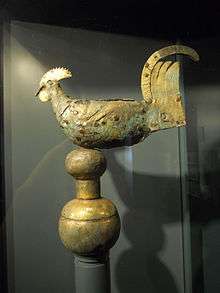Weather vane






A weather vane, wind vane, or weathercock is an instrument for showing the direction of the wind. They are typically used as an architectural ornament to the highest point of a building.
Although partly functional, weather vanes are generally decorative, often featuring the traditional cockerel design with letters indicating the points of the compass. Other common motifs include ships, arrows and horses. Not all weather vanes have pointers.
The word 'vane' comes from the Old English word fana meaning 'flag'.
History
The Tower of the Winds on the ancient Greek agora in Athens once bore on its roof a wind vane in the form of a bronze Triton holding a rod in his outstretched hand, rotating as the wind changed direction. Below this was a frieze adorned with the eight Greek wind deities. The eight-metre-high structure also featured sundials, and a water clock inside. It dates from around 50 BCE.[1]
The oldest existing weather vane with the shape of a rooster is the Gallo di Ramperto, made in 820 CE and now preserved in the Museo di Santa Giulia in Brescia, Lombardy.[2][3]
Pope Leo IV had a cock placed on the Old St. Peter's Basilica or old Constantinian basilica.[4]
Pope Gregory I said that the cock (rooster) "was the most suitable emblem of Christianity", being "the emblem of St Peter", a reference to Luke 22:34 in which Jesus predcits that Peter will deny him three times before the rooster crows.[5][6]
As a result of this,[5] the cock gradually began to be used as a weather vane on church steeples, and in the 9th century Pope Nicholas I[7] ordered the figure to be placed on every church steeple.[8]
The Bayeux Tapestry of the 1070s depicts a man installing a cock on Westminster Abbey.
One alternative theory about the origin of weathercocks on church steeples is that it was an emblem of the vigilance of the clergy calling the people to prayer.[9]
Another theory says that the cock was not a Christian symbol[10] but an emblem of the sun[11] derived from the Goths.[12]
A few churches used weather vanes in the shape of the emblems of their patron saints. The City of London has two surviving examples. The weather vane of St Peter upon Cornhill is not in the shape of a rooster, but a key;[13] while St Lawrence Jewry's weather vane is in the form of a gridiron.[14]
Early weather vanes had very ornamental pointers, but modern wind vanes are usually simple arrows that dispense with the directionals because the instrument is connected to a remote reading station. An early example of this was installed in the Royal Navy's Admiralty building in London - the vane on the roof was mechanically linked to a large dial in the boardroom so senior officers were always aware of the wind direction when they met.
Modern aerovanes combine the directional vane with an anemometer (a device for measuring wind speed). Co-locating both instruments allows them to use the same axis (a vertical rod) and provides a coordinated readout.
World's largest weather vane
According to the Guinness World Records, the world's largest weather vane is a Tío Pepe sherry advertisement located in Jerez, Spain. The city of Montague, Michigan also claims to have the largest standard-design weather vane, being a ship and arrow which measures 48 feet tall, with an arrow 26 feet long.[15]
A challenger for the title of world's largest weather vane is located in Whitehorse, Yukon. The weather vane is a retired Douglas DC-3 CF-CPY atop a swiveling support. Located at the Yukon Transportation Museum[16] beside Whitehorse International Airport, the weather vane is used by pilots to determine wind direction, used as a landmark by tourists and enjoyed by locals. The weather vane only requires a 5 knot wind to rotate.[17]
Slang term
The term "weathervane" is also a slang word for a politician who has frequent changes of opinion. The National Assembly of Quebec has banned use of this slang term as a slur after its use by members of the legislature.[18]
See also
- Windsock, in aviation
- Apparent wind indicator, in sailing
- List of weather instruments
- Old Father Time, a famous weather vane at Lord's Cricket Ground, London
- Weather station
- Examples of weather vanes as sculptures
References
- ↑ Noble, Joseph V.; Price, Derek J. de Solla (October 1968). "The Water Clock in the Tower of the Winds". American Journal of Archaeology. 72 (4): 345–355 (353). JSTOR 503828. doi:10.2307/503828.
- ↑ Rossana Prestini, Vicende faustiniane, in AA.VV.,La chiesa e il monastero benedettino di San Faustino Maggiore in Brescia, Gruppo Banca Lombarda, La Scuola, Brescia 1999, p. 243
- ↑ Fedele Savio, Gli antichi vescovi d'Italia. La Lombardia, Bergamo 1929, p. 188
- ↑ ST PETER'S BASILICA.ORG - Providing information on St. Peter's Basilica and Square in the Vatican City - The Treasury Museum
- 1 2 John G. R. Forlong, Encyclopedia of Religions: A-d - Page 471
- ↑ The Antiquary: a magazine devoted to the study of the past, Volume 17 edited by Edward Walford, John Charles Cox, George Latimer Apperson - page 202
- ↑ Jerry Adler; Andrew Lawler (June 2012). "How the Chicken Conquered the World". Smithsonian.
- ↑ The Philadelphia Museum bulletin, Volumes 1-5 - By Pennsylvania Museum of Art, Pennsylvania Museum and School of Industrial Art, Philadelphia Museum of Art - p 14 - 1906
- ↑ Thomas Ignatius M. Forster, Circle of the Seasons, p. 18
- ↑ William White, Notes and Queries
- ↑ Hargrave Jennings, Phallicism, p. 72
- ↑ William Shepard Walsh, A Handy Book of Curious Information
- ↑ "History of London: Vanity and Wind". Wordpress. Retrieved 1 June 2016.
- ↑ "Our Weather Vane". St Lawrence Jewry. Retrieved 1 June 2016.
- ↑ "The World's Largest Weather Vane - Ella Ellenwood". Retrieved 2010-06-01.
- ↑ goytm.ca
- ↑ "DC-3 CF-CPY: The World's Largest Weather Vane - ExploreNorth". ExploreNorth. Retrieved 2010-02-13.
- ↑ "Quebec bans 'weathervane' insult". Metro. 2007-10-17. Retrieved 2010-02-13.
Further reading
Bishop, Robert; Coblentz, Patricia (1981), A Gallery of American Weather Vanes and Whirligigs, New York: Dutton, p. 127, ISBN 9780525931515
Burnell, Marcia (1991), Heritage above: a tribute to Maine's tradition of weather vanes, Camden, ME: Down East Books, p. 84, ISBN 9780892722785
Crépeau, Pierre; Portelance, Pauline (1990), Pointing at the wind : the weather-vane collection of the Canadian Museum of Civilization, Hull, Quebec: Canadian Museum of Civilization, p. 84, ISBN 9780660129044
Kaye, Myrna (1975), Yankee weathervanes, New York: Dutton, p. 236, ISBN 9780525238591
Klamkin, Charles (1973), Weather Vanes: The history, design and manufacture of an American folk art, New York: Hawthorn Books, p. 209, OCLC 756017
Lane Arts Council (Or.) (1994), Whirligigs & weathervanes, Eugene, OR: Visual Arts Resources, p. 54, OCLC 33052846
Lynch, Kenneth; Crowell, Andrew Durkee (1971), Weathervanes, Architectural Handbook series, Canterbury, CN: Canterbury Publishing Company, p. 95, OCLC 1945107
Messent, Claude John Wilson (1937), The weather vanes of Norfolk & Norwich, Norwich: Fletcher & Son Limited, p. 127, OCLC 5318669
Miller, Steve (1984), The art of the weathervane, Exton, PA: Schiffer Pub., p. 160, ISBN 9780887400056
Mockridge, Patricia; Mockridge, Philip (1990), Weather vanes of Great Britain, London: Hale, p. 256, ISBN 9780709037224
Needham, Albert (1953), English weather vanes, their stories and legends from medieval to modern times, Haywards Heath, Sussex: C. Clarke, p. 102, OCLC 1472757
Nesbitt, Ilse Buchert; Nesbitt, Alexander (1970), Weathercocks and weathercreatures; some examples of early American folk art from the collection of the Shelburne Museum, Vermont., Newport, RI: Third & Elm Press, OCLC 155708
Reaveley, Mabel E.; Kunhardt, Priscilla (1984), Weathervane secrets, Dublin, NH: W.L. Bauhan, p. 71, ISBN 9780872330757
Westervelt, A. B.; Westervelt, W. T. (1982), American Antique Weather Vanes: The Complete Illustrated Westervelt Catalog of 1883, New York: Dover, p. 100, ISBN 9780486243962
External links
![]() Media related to Weather vane at Wikimedia Commons
Media related to Weather vane at Wikimedia Commons